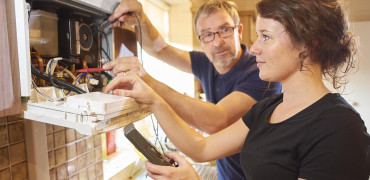This is my final blog for the Hub for a while. I’m taking a break, but it’s been very fulfilling to get some thoughts out there on the wider industry as well as some things closer to home – even, occasionally, heat pumps. So, many thanks for reading.
2023 was, as we expected, a really tough time for smaller housebuilders, with house prices taking a dive but everything else getting more expensive and difficult.
But there’s a lot happening in 2024, which is good or bad news, depending on whether you like change, and some positive challenges.
The key difference is that the UKGBC’s standard isn’t owned by any one organisation or institute
Future standards
The draft version of the Future Homes Standard has finally been handed to the industry, to take a look at what the Government is intending to bring in, just a year from now.
The consultation document includes detail on what housebuilders will be expected to deliver, to produce drastically higher levels of energy efficiency in new homes as we attempt to move towards net zero 2050.
However, it also includes clear statements on what the standard does not cover, and this has led to strong criticism from the UK Green Building Council (UKGBC) that it is the “least ambitious” route that the Government could have taken.
It implicitly prioritises low carbon heating rather than installing PVs by default, ironically because the grid is increasingly decarbonised, and this isn’t going down at all well with the eco-conscious fraternity, nor is the absence of a requirement for embodied carbon calculation.
Futureproof
At the same time, it still presents the challenge of 75%-80% fewer carbon emissions per home.
This has to be addressed with a combination of a much more painstakingly constructed, and highly insulated fabric, renewables like PVs, and low carbon heating – most likely air source heat pumps.
The Good Homes Alliance says the new standard is a “business as usual charter,” which doesn’t sound like it will actually result in those emissions reductions.
Others have said that existing homes are already being built with higher standards than the Future Homes Standard.
The more eco-evangelist housebuilders (or at least those with clients of that ilk), will know that UKGBC is due to publish its ‘beta’ (test) version of its Net Zero Carbon Buildings Standard in spring 2024.
It is likely to be far more onerous, but thereby more ‘futureproof,’ than the Future Homes Standard.
Net zero future
While the Government’s standard is set up to make buildings ‘net zero ready,’ the UKGBC’s will actually provide ‘net zero’ constructions towards the 2035 non-binding 78% CO2 reduction the UK has signed up to; well that’s the idea anyway.
The key difference between the two standards is that the UKGBC’s includes embodied carbon, but it also aims to provide “clear, consistent definitions and trajectories to net zero buildings,” and to be “collaboratively created by, and for, the built environment industry, and not owned by any one organisation or institute.”
The UKGBC also says a benefit of its standard is that it’s “politically neutral,” a dig at the Future Homes Standard, which is necessarily political being Governnment-driven.
Biodiversity and SuDS
There’s an awful lot of noise in the industry and outside it, all trying to push things in the right direction, but with varying degrees of realism, and success.
Part Z (the mythical industry-generated Building Regulation on embodied carbon) is somewhere in Bill form in the Houses of Parliament. Whether it will ever see the light of day is anyone’s guess, particularly as a General Election is likely this autumn.
In the meantime, something that’s tangible is that you’ll need to deliver an extra 10% of Biodiversity Net Gain on your developments this year, as it becomes a legal requirement this month.
However, while this might seem another headache on the surface, one way to get species to thrive on your sites is to introduce Sustainable Urban Drainage Systems, in the form of natural SuDS features such as swales and rain gardens which not only tackle surface water but also provide a home for insects, mammals and birds.
This is also becoming a requirement in 2024, so our recent round table was very well timed, bringing together housebuilders, SuDS experts and product suppliers to discuss the nuts-and-bolts of doing it right, and busting some myths in the process.
You can find a podcast with the highlights of the debate here - Building Insights, they provide some really interesting food for thought, and a white paper reviewing the event at www.hbdonline.co.uk
Shocking approvals
Barbour Index recently put out some startling figures showing just how down in the mouth the residential market is, despite a small lull in house price drops. Residential approvals are at a “shocking” level, they said, down 25% on this time last year.
This might change for the better if there’s a change of administration, we can only hope that industry initiatives don’t get kicked down the road or watered down quite so often under Labour.
However, a lot of those initiatives do bring extra challenges for housebuilders, so it’s swings and roundabouts.
More and more housebuilders, especially at the smaller end, are moving out of new build into the RMI sector, because that’s where the work is, and that’s where any growth in construction is coming from.
It’s probably a lot harder, in practical terms, if we are talking deep retrofit rather than extensions (something we will stage a round table on in 2024 with the Federation of Master Builders). But retrofit is the major nut to crack in our zero carbon challenge, so that might be the silver lining in terms of net zero that results from this potential paradigm shift in the industry.
Achievability versus cost
The Government (new or existing) needs to do its part by not scrapping useful initiatives, such as the Conservatives regrettably did with the Code for Sustainable Homes, and the (admittedly fanciful) 2016 zero carbon homes target itself.
They also need to make life easier for small builders to engage in this process now, not wait until the industry is failing to deliver.
Now we have the Future Homes Standard, let’s make the best of it, so it becomes a robust document the industry can work with to produce better buildings for future generations.
It needs to be improved and strengthened, but the balance has to be struck with achievability and cost. To reinvent this wheel again from scratch would be something close to criminal negligence.
James Parker Managing editor of Housebuilder and Developer




